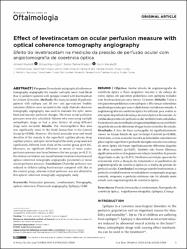Effect of levetiracetam on ocular perfusion measure with optical coherence tomography angiography
Citation
Kaderli A, Kayılıoğlu H, Kaderli ST, Karalezli A. Effect of levetiracetam on ocular perfusion measure with optical coherence tomography angiography. Arq Bras Oftalmol. 2023 Oct 20;87(6):e20220269. doi: 10.5935/0004-2749.2022-0269. PMID: 37878878.Abstract
Purpose: To evaluate using optical coherence tomography angiography the macular and optic nerve head blood flow in pediatric patients with epilepsy treated with levetiracetam for at least 12 months.
Methods: This study included 33 pediatric patients with epilepsy and 30 sex- and age-matched healthy volunteer children were included in the study. Optical coherence tomography angiography was used to evaluate the optic nerve head and macular perfusion changes. The mean ocular perfusion pressures were also calculated. Patients who were using multiple antiepileptic drugs or had a prior history of using different drugs were excluded.
Results: The choriocapillaris flow area was significantly lower in the Study Group than in the Control Group (p=0.006). However, the foveal avascular zone and vessel densities of the macula in the superficial capillary plexus, deep capillary plexus, and optic nerve head of the study group were not significantly different from those of the control group (p>0.05). Moreover, no significant difference in means of mean ocular perfusion pressure was found between the two groups (p=0.211). No obvious correlation was found between treatment duration and optical coherence tomography angiography parameters or mean ocular perfusion pressure.
Conclusion: Choroidal perfusion was reduced in children taking levetiracetam compared with that in the control group, whereas retinal perfusion was not affected in this optical coherence tomography angiography study.


















